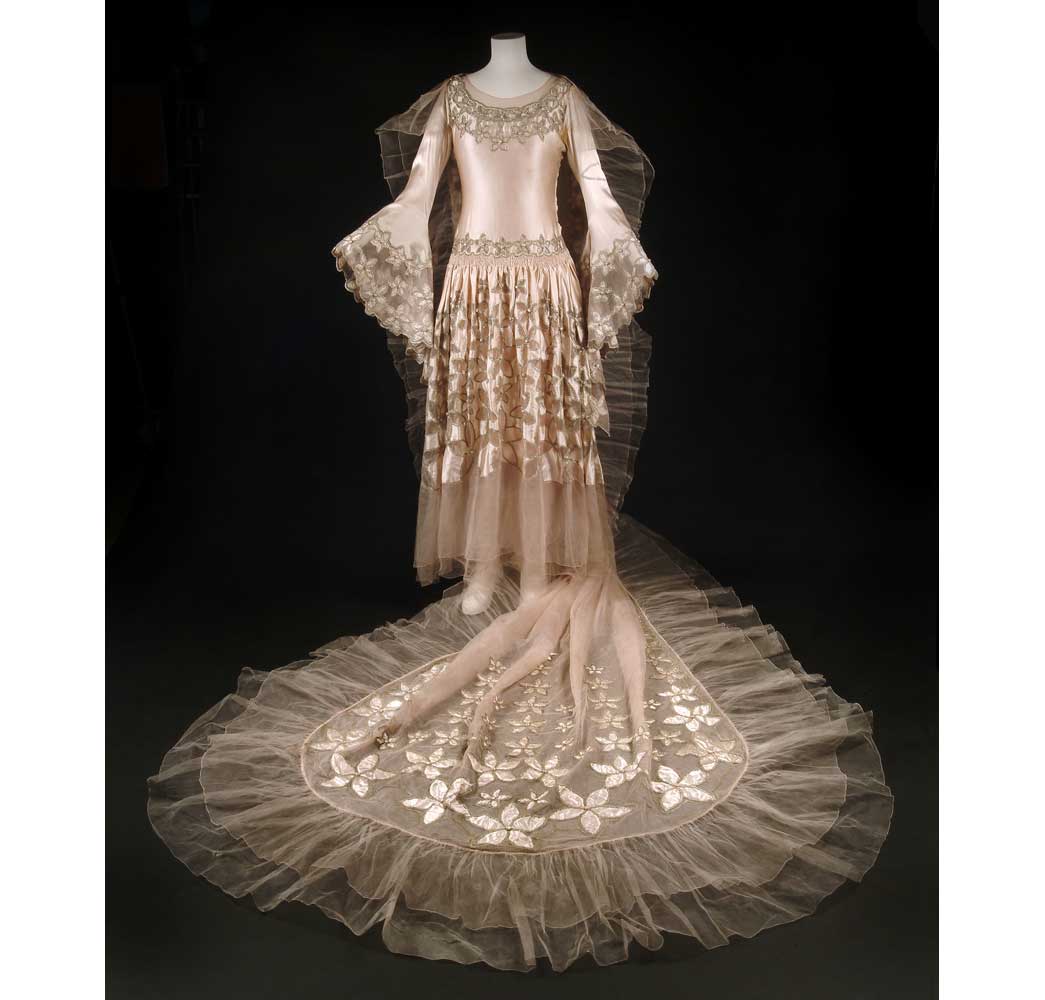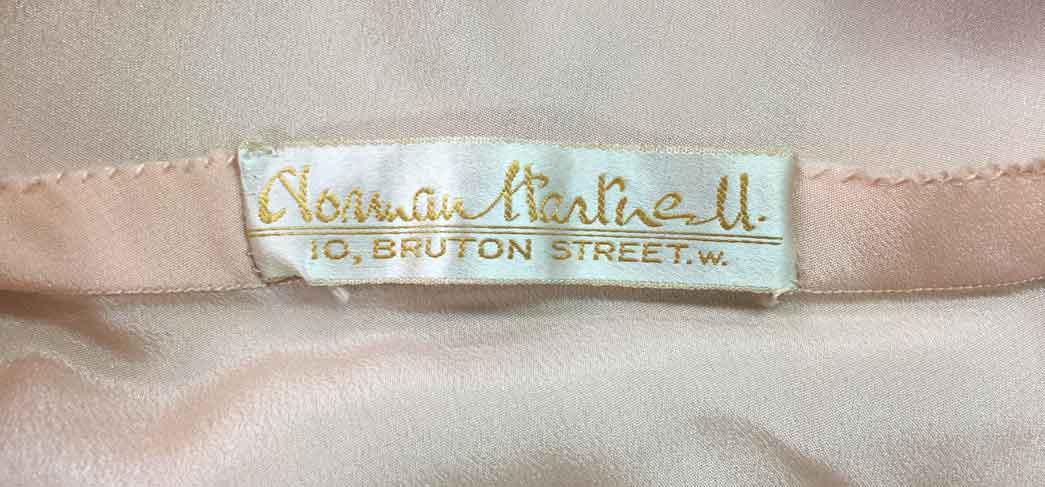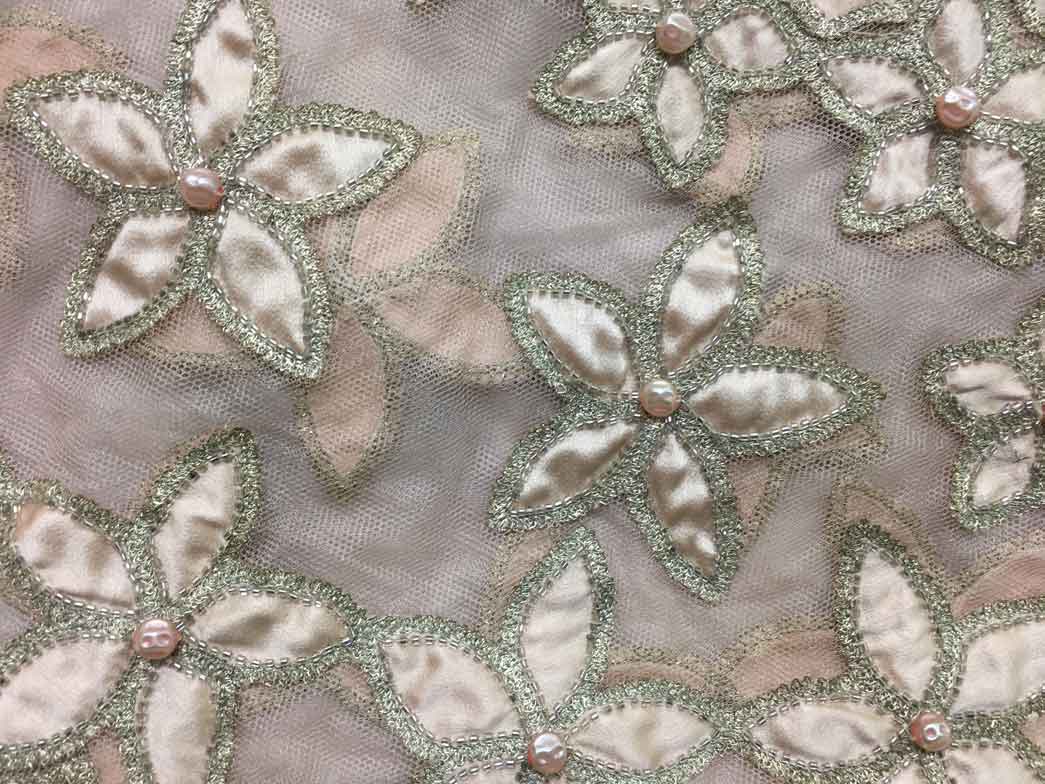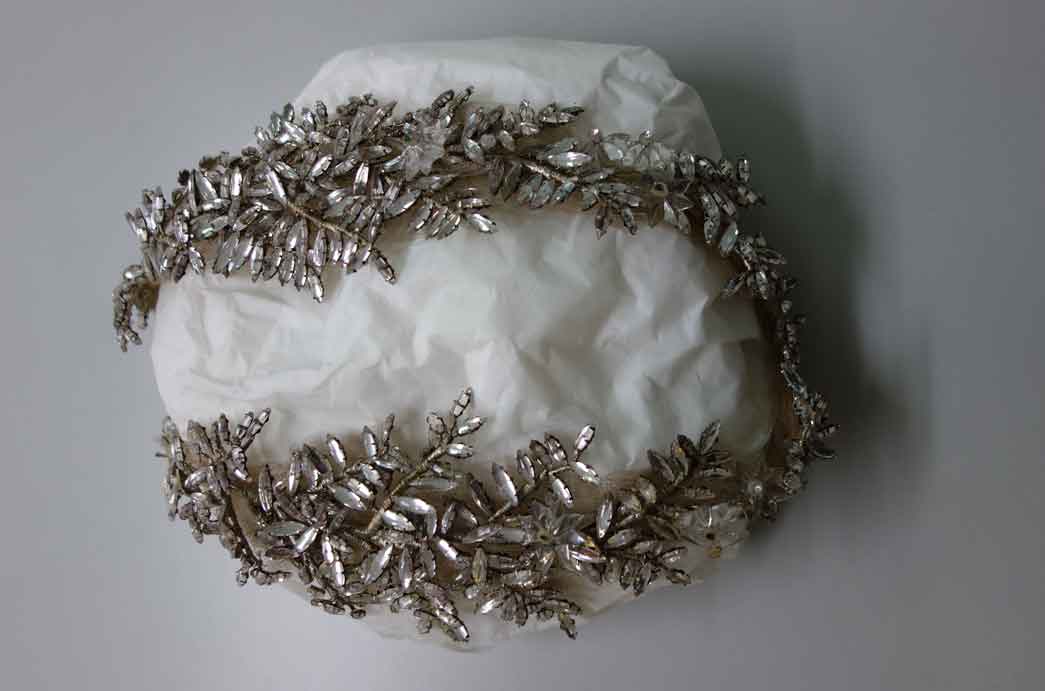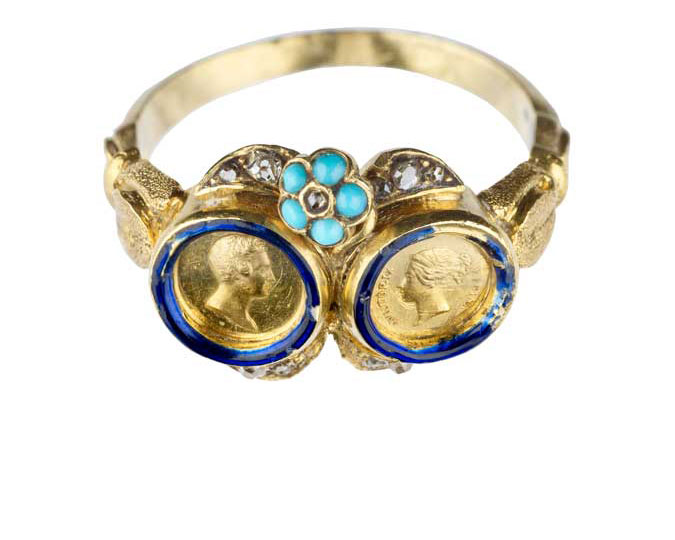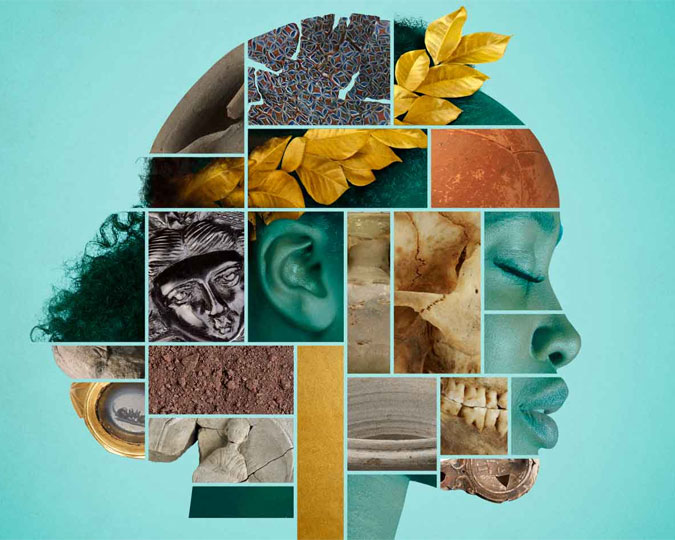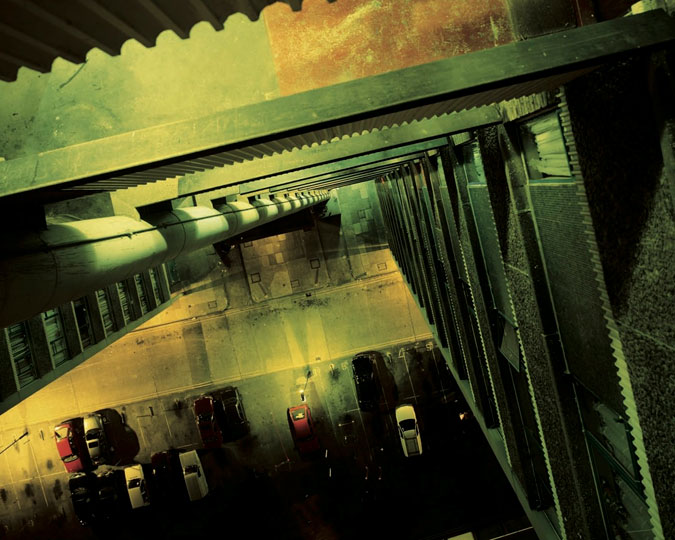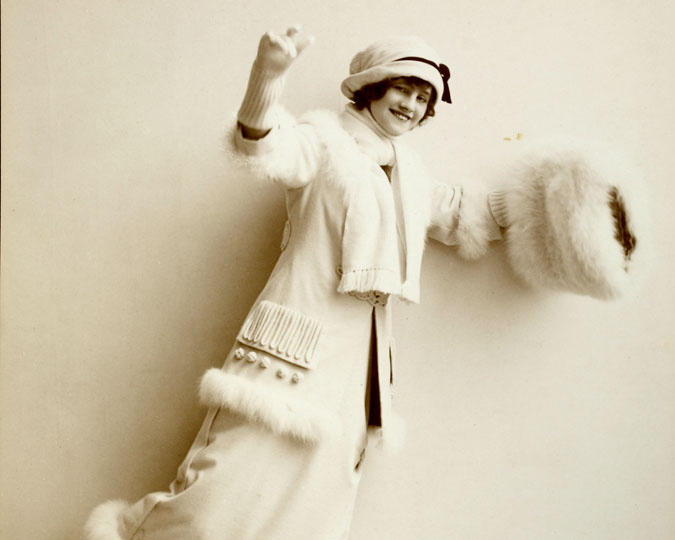Fashion curator Beatrice Behlen delves into the surprising story behind a spectacular wedding dress. Did this dress, first worn ninety years ago, inspire the outfit worn by Queen Elizabeth when she was married in 1947?
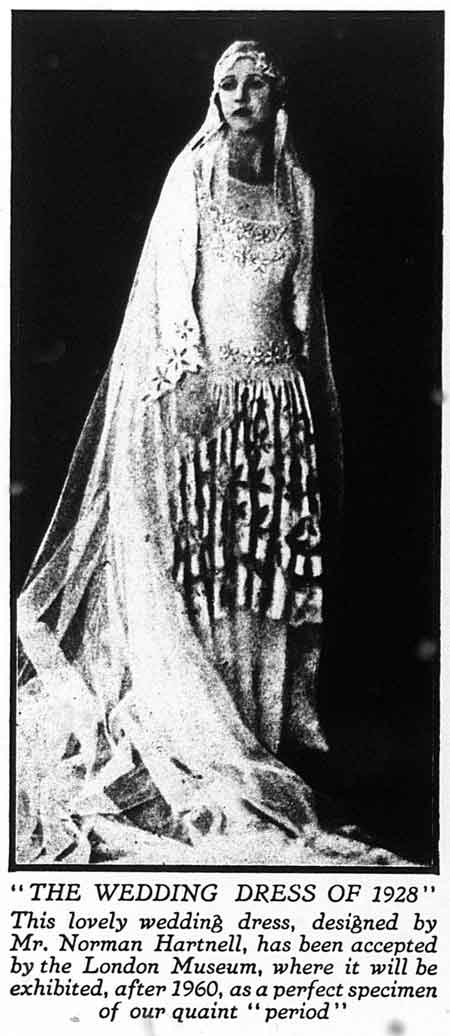
Detail from The Graphic, 26 May 1928
On 26 May 1928, the weekly illustrated newspaper The Graphic treated its readers to a photograph of a beautiful bride with this caption:
This lovely wedding dress, designed by Mr. Norman Hartnell, has been accepted by the London Museum, where it will be exhibited after 1960, as a perfect specimen of our quaint “period”.
Two months earlier, on 28 March 1928, the dress had indeed been presented to the museum by the woman in the photograph: Mrs. Carl Bendix of 19 New Cavendish Street. However, Mrs Bendix had not worn the dress to her wedding.
Before we unravel this story, let us first have a proper look at the gown. It is ankle-length, made of pale pink satin. Like the matching train of pink silk net, the satin is decorated with five-petalled flowers outlined in clear glass bugle beads, bordered by silver metal thread in chain stitch. The petals are either cut into the satin, or petal-shaped satin is applied to the parts made of net. The centre of each flower is formed by a single cabochon pearl, dyed pale pink.
The dress features the dropped waist typical of the 1920s but it also has a distinctly medieval flair which derives from its neckline, the simple cut of its upper part and the bell-shaped, long sleeves. Think medieval gowns as interpreted by the Pre-Raphaelites such as John William Waterhouse’s Lady of Shallot. To ensure that the top part sits smoothly over the wearer’s torso, ten circular metal weights are suspended from tapes attached internally to the waistline. The dress was worn over a pale pink crepe de chine silk slip with two deep layers of net attached attached to hem. To the slip’s seam allowance a woven label had been stitched bearing its designer’s name and address: ‘Norman Hartnell / 10 Bruton Street W’.
Hartnell had set up his fashion business only in April 1923, showing his first collections the following year. When he designed a wedding dress for his friend Daphne Vivian for her marriage to Henry Thynne, 6th Marquess of Bath in October 1927, Hartnell studied Renaissance and medieval paintings which continued to influence his designs for a number of years. The dress worn by Mrs. Bendix was a precursor of a fashion that swept through high society.
The couturier made a dress almost identical to ours (now in the Bowes Museum) for Joan Redhead who married John Raymond Roper on 24 July 1928 at St Margaret’s Westminster, a popular church for society weddings. It was described in The Times the next day as ‘a picture gown of ivory satin embroidered with crystal bugles, pearls and silver thread, and finished with a deep hem of white tulle and long flowing sleeves’, the white tulle train being ‘bordered by appliquéd satin flowers, embroidered in the same design as the gown.’ Even more spectacular was Hartnell’s medievalist creation for Margaret Whigham, later the Duchess of Argyll, for her marriage to Mr Charles Sweeny at the Brompton Oratory on 21 February 1933, which is now in the Victoria & Albert Museum. And some have seen similarities to one of Hartnell’s most famous creations: the wedding dress worn by Princess, now Queen Elizabeth in 1947, which was famously inspired by Sandro Botticelli’s painting of Primavera, now in the Uffizi Gallery in Florence.
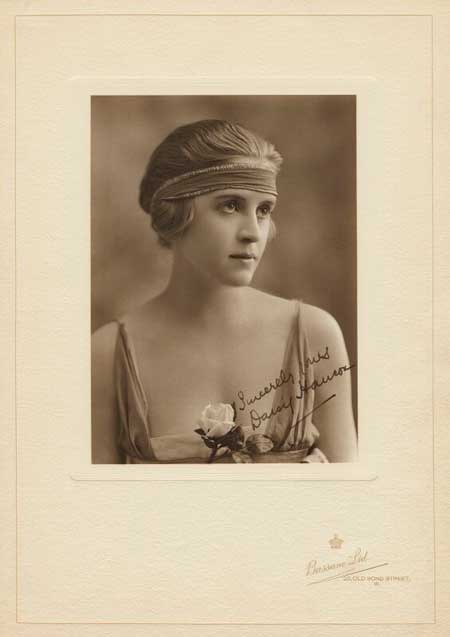
Daisy Hancox
Photographed by Bassano Studio. National Portrait Gallery collection.
But why did Mrs Bendix wear Hartnell’s wedding dress if not for her wedding? Mrs Bendix was born Daisy Hancox in 1894 in Wandsworth, daughter of a police constable. During the First World War Daisy joined Richard Daly’s theatre, where she progressed from understudy to leading lady by October 1916, around the time a series of photos of her were taken by the Bassano Studio.
The following year Daisy accepted an engagement with the theatrical manager and impresario C.B. Cochrane, appearing in a number of his revues. Tuberculosis seems to have put an end to her theatrical career, she is last mentioned in The Times in June 1920 when she appeared in the musical Irene at London’s Empire Theatre. On 7 October 1921 Daisy married the stockbroker Carl Alfred Bendix at the Marylebone register office. We do not know what Daisy wore on that occasion, but she certainly would not have required an elaborate wedding dress.
There might have been a reason why Daisy’s wedding was low-key. Her husband’s first wife had just been awarded £5,000 for ‘breach of promise’. According to the court proceedings published in great detail seemingly in most newspapers in the country, Mr Bendix’s first marriage had been dissolved after 14 years in February 1921. Not long thereafter he had promised his divorced wife, or so she alleged, to remarry her, had postponed this marriage several times until finally, ‘on October 7 he married a young lady who was on the stage’ (Manchester Guardian, 24 February 1922).
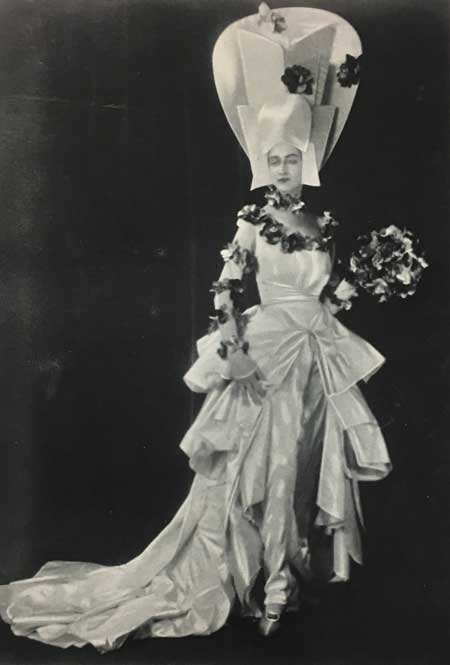
Ready for Ascot, 2000 A.D
Image from The Sketch: "Wearing a racing 'Fashion of the Far Future': the Hon. Mrs. Freeman-Thomas at the 'Dream of Fair Women' ball."
This unfortunate incident seems to have been forgotten a few years later. In December 1927 Mrs Carl Bendix appeared as one of presumably twelve society women representing the signs of the Zodiac at a pageant in aid of St John’s Hospital, Lewisham. Charity balls incorporating elaborate pageants were extremely popular in the interwar years and the frequently outlandish costumes were often photographed for society magazines.
On 29 February 1928 The Sketch published photographs by Bertram Park of some of the participants in another forthcoming pageant. It was reported that their costumes had been made for the “Dream of Fair Women” ball that same evening at Claridge’s hotel in aid of the Winter Distress League. Promising to be ‘one of the most brilliant “in-aid-of” festivities of the pre-Easter season’, the ball included a Parade of Fashion featuring ‘Past, Present, and Future Fashions’. The latter were designed by no other than Cecil Beaton, described as ‘well-known amateur photographer and dress designer’, who came up with outfits for ‘the Nun of 1980’, ‘the Bride of 2028’ - ‘dress of Directoire tendencies with a mammoth ruffle’ worn by Beaton’s sister Baba, ‘the Bather of the future’ and ‘the Huntswoman of 1960’.
My personal favourite is ‘the Going-Away costume for the Bride of 1940’, a kind of jumpsuit with knee breeches embroidered with propellers and aeroplanes and accessorised with a silver aviator’s helmet. Mrs Bendix’s ‘beautiful modern bridal dress’ almost seems boring compared with these extravaganzas.
I am intrigued by the care that Hartnell put into a gown that was only going to be worn for one evening- although I suppose wedding dresses are generally put on for just a few hours. I wonder whether Mrs Bendix only wore it during the pageant, slipping into something more comfortable for the rest of the evening. Hartnell, of course, would have known that his dress was going to be seen by a large number of society women who might well have taken note for future reference.
The fact that the dress was donated by Mrs Bendix, and not by the couturier, suggests that it belonged to her. Maybe she had to pay for it herself, as a contribution to the charity? It must have been a strange having a wedding dress at home that was not your own and I am not surprised – although very glad – that she decided to part with it.
Apparently, Daisy got involved with the rasher dashing Brigadier-General Alfred Cecil Critchley, himself a married man. Carl Alfred Bendix was granted a decree of divorce in May 1936. In November that year, Daisy married another military man, Captain Lionel Cotterill Neame who worked for the Special Operations Executive in the Second World War. We do not know what Daisy wore, but we do know that the couple chose to get married at St Ethelburga’s, called in The Bystander ‘that quaint old City church that rescues twice-marrieds from the banality of a registry office’ (18 November 1936).
In 1949, Daisy married a third and last time, becoming the second wife of Lieutenant Colonel Dudley Jaffray Hynman Allenby, 2nd Viscount Allenby of Megiddo. This marriage was to last more than 30 years until Viscount Allenby’s death in 1984. Daisy died the following year.
Her magnificent dress remains in the Museum of London collection, an enduring part of London's fashion history.
Love fashion? Subscribe to our free fashion newsletter to read more stories from our collections, and see upcoming events and exhibitions.








